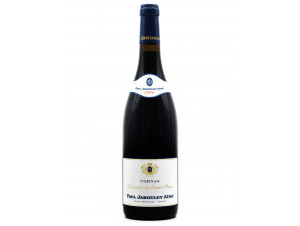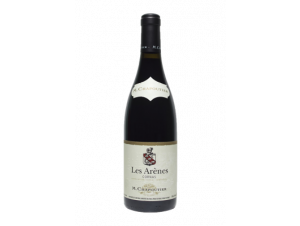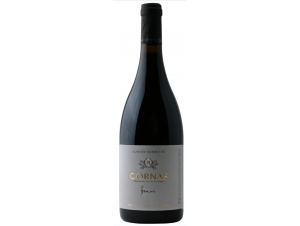You have no items in your shopping cart.
Wine Cornas
-
Top Selling
-
Top Selling
-
Top Selling
- -17%
- -24%
- -17%
Cornas is a most prestigious appellation
The Romans were once again the precursors of vine cultivation in the region. They were the ones who created the first "chaillées", low walls allowing the organisation of the vineyard in terraces, and thus simplifying the cultivation of the vine in the relief of the region. Few traces of the wine produced at the time have come down to us, except for the Canon of Viviers who alludes in the 10th century to the Church of Cornas, which he says was "surrounded by vines".
Later, in the 18th century, some writings mention "a powerful wine", often described as "quite black". Since the 19th century, the vineyard of Cornas has been one of the most prestigious, identified as the best wine of the northern Rhone Valley, just after the Hermitage. Its history is even more glorious than that of the appellation Côte-Rôtie! Indeed, the proximity of the town and appellation of Saint-Péray, where exceptional whites have been produced for centuries, has intensely boosted the trade in the region for a long time.
The town of Cornas, over which the Cornas appellation extends, is situated on the eastern slopes of the Massif Central. A natural amphitheatre is formed by various hillsides to the south and east. The vines are thus protected from cold winds. Being located opposite Valence, the AOC Cornas is one of the most urbanised appellations that exist in France. The AOC has expanded greatly over time: it was only about 50 hectares in the post-war period, and today there are 150 hectares of vines producing Cornas.
The "new lands" of the AOC were annexed by clearing abandoned lands, and by going up on some hillsides as well as on plateaus located at altitude. Some plots of land reach an altitude of 350 metres. The plateaus are easier to cultivate than the hillsides, as they do not need to be planted in stakes, where several stakes are necessary to plant and maintain a single vine, but the traditional trellises are enough to make the vine grow towards the sky.
The 150 hectares of Syrah produce an average of 4,918 hectolitres, with an average annual yield of 33 hectolitres per hectare. The appellation has been protected and recognised since 1938, and was therefore one of the first AOCs to be registered.
Cornas has "superstar" terroirs
The terroir is particularly conducive to the growth of Syrah, the one and only grape variety allowed in the Cornas AOC: all Cornas are therefore red wines. The soils are divided into three quite different typicities. Acidic soils of arena and granite on the upper part of the commune, high terraces composed of pebbles and granite on the central part of the AOC and chalky deboulis make up the lower slopes.
Some terroirs are exceptional and therefore very well known under the names of lieux-dits, such as Reynard, La Geynale, Chaillot or even Patou. Each of these terroirs brings different qualities to Syrah: Chaillot, for example, allows Syrah to be particularly silky, as the soils are more clayey. The best known hillside of all is Reynard, it is sheltered from the winds, particularly granitic, and produces deep and spicy Syrahs.
The climate is relatively temperate though Mediterranean, as the vines are at altitude, and the mistral wind frequently sweeps through the region. There is plenty of sunshine, and moderate rainfall. The weather conditions are therefore perfect for the culture of Syrah.
Cornas is a powerful and balanced wine
To the eye, the wines of Cornas are a very strong, deep red. They deserve to be called "black wines". With age, they develop more tiled notes, often ranging from ruby to garnet.
The nose is very deep and the wine is very dark.
The nose is very expressive, but the aromas expressed are very fine and velvety, mostly on notes of red fruits and wild flowers. Blackberry, cherry, pepper, undergrowth and spices are the dominant aromas of Cornas. After 5 or 6 years of ageing, more and more aromas express themselves and allow it to reveal its full potential, through aromas of truffle, leather, tobacco.
On the palate, Syrah expresses a very good balance, between voluptuousness and structure, but still with great power. These barrel-aged wines are very woody and tannic in their youth. They need at least 5 years of ageing before they are ready for drinking, and can age up to 18 or 20 years. The tasting notes are then truffled, red fruit, slightly amber.
How to pair a Cornas
The power of these wines promises magnificent pairings with game dishes, such as hare à la royale, venison jig or stuffed thrush. They are also a perfect accompaniment to truffle-based dishes, or strong cheeses such as blue cheese.
The domains to discover in Cornas
Domaine du Tunnel
In 1994, Stéphane Robert created his 2.5 hectare estate. Thanks to the success of his wines, he now vinifies 11 hectares, in several different AOCs: Cornas, Saint-Péray, Saint-Joseph and Condrieu. The wines are matured with passion, in oak barrels. This Cornas is particularly representative and typical of the AOC.Paul Jaboulet Aîné
A must in the Rhône Valley, Domaine Paul Jaboulet Ainé was created in 1834, and its reputation has since crossed the centuries. The wines of this estate, produced using sustainable agriculture and respecting the environment, are known throughout the world. Whether in Cornas, Côte-Rôtie, Châteauneuf-du-Pape, Condrieu or Crozes-Hermitage, the wines are always representative of their appellations, and express to perfection the particularities of these exceptional terroirs.Clairette-de-Die
Côtes du Rhône Villages Suze-la-Rousse
Côtes-du-Rhône Villages Sainte-Cécile
Côtes-du-Rhône-Villages Chusclan
Côtes-du-Rhône-Villages Laudun
Côtes-du-Rhône-Villages Massif-d'Uchaux
Côtes-du-Rhône-Villages Plan-de-Dieu
Côtes-du-Rhône-Villages Rochegude
Côtes-du-Rhône-Villages Sablet
Côtes-du-Rhône-Villages Séguret
Côtes-du-Rhône-Villages Signargues
Vin de Pays des Collines Rhodaniennes
Vin de Pays des Collines Rhodaniennes



































 TWIL - Achat de Vin
TWIL - Achat de Vin


